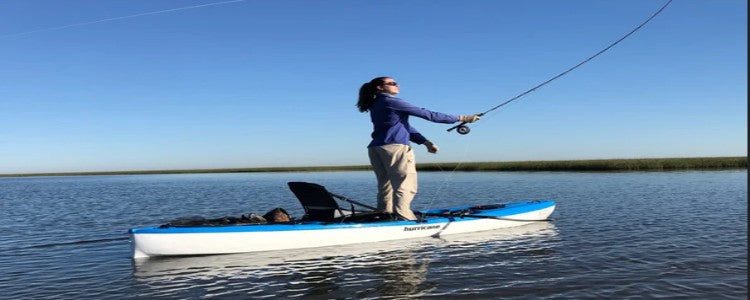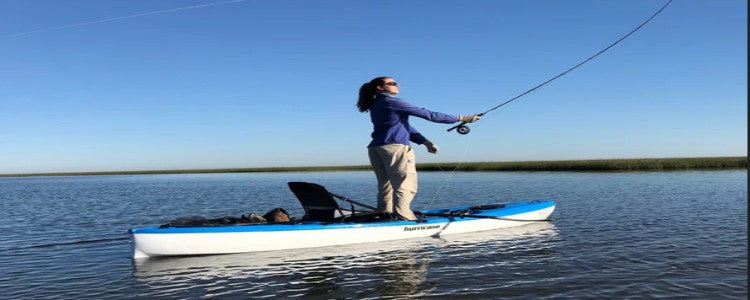Are you a fan of both fishing and kayaking? With the warmer months right around the corner, now could be the perfect time to buy a brand-new fishing kayak. These kayaks come with a range of unique features and functions that specifically lend themselves to fishing expeditions.
Before you invest, it’s important to understand what makes them different from traditional kayaks, what features to prioritise, and how to safely navigate open waters. So, if you’re still unsure whether this style is right for you, here are ten of the most common questions we get asked!
1. What's the Difference Between Fishing and Traditional Kayaks?
First things first, let’s explain what separates fishing kayaks from your average recreational or touring model. Fishing kayaks are specifically designed for anglers and prioritise stability, storage, and comfort over speed.
Another notable feature you’ll find are wider hulls, a design element that allows for easier standing when casting, plus specialised compartments and mounts for fishing gear. Most fishing kayaks are sit-on-top designs that provide better stability and allow anglers to move freely.

The Viking Profish GT kayak in action!
Traditional kayaks, on the other hand, are typically narrower and built for speed, agility, and touring. They’re a great option for recreational paddling, long-distance journeys, or exploring calm waterways, but often lack the built-in features that make fishing more convenient.
Basically, the first question to ask here is whether your primary activity is paddling or fishing.
2. What Are Some Features to Look for in a High-Quality Fishing Kayak?
If you’re ready to start checking out a few fishing kayaks, focus on features that improve both performance and convenience:
Stability: A wide, flat hull ensures the kayak remains steady, especially when standing to cast or reel in a catch. Stability is critical for safety and comfort during extended sessions on the water.
Storage and Gear Capacity: Fishing requires multiple accessories such as tackle boxes, coolers, and nets. Look for kayaks with well-organised compartments, hatches, and deck bungees to securely store your gear.
Comfort and Ergonomics: A framed adjustable seat and footrests are vital. Long days on the water can become uncomfortable without proper support. Some models offer elevated seating for better visibility when fishing.

The Hurricane USA Sweetwater 126 (with rudder). Available Now!
Portability and Weight: Fishing kayaks are generally heavier than traditional kayaks, normally ranging from 20 to 40 kgs. It's good to keep this in mind as your ability to move the kayak to and from and off the water is a key consideration.
Durability and Build Quality: If well-made, a fishing kayak will be able to withstand various conditions and last for many fishing seasons. A durable option should also be capable of handling rough waters, impacts, and prolonged exposure to the elements.
3. Can I Customise My Fishing Kayak?
Yes, one of the key advantages of fishing kayaks is the ease of customisation. You can add fish finders, GPS units, anchor systems, extra rod holders, or even specialised storage trays. Of course, the add-ons should always fit onto your model and be the correct size and shape, etc.
The only caution is to avoid modifications that compromise stability or safety. Make sure to invest in a supportive seat and leg supports, dress for the conditions, stay hydrated, and use a front or rear-mounted anchor to stay in position safely. These simple tweaks let you tailor your kayak to your style and make the most of your time on the water.
4. Is a Fishing Kayak Suitable for Open Water?
Kayak fishing in open waters can be an amazing experience, but it definitely comes with additional risks and hazards, so preparation is absolutely crucial. Always check the weather ahead of time, as well as any reports on wind, swell, and tide. Services like WillyWeather and the Bureau of Meteorology are great sources for this kind of info.
Wear a properly fitted, AS4758.1-certified life jacket at all times. Pack water, snacks, sun protection, a whistle, knife, head torch, and a dry bag with spare clothes. From here, only head out if the conditions are suitable, you’re confident with your paddling skills and know how your kayak handles in waves and currents.
Once out on the open water, use an anchor or drift chute to stay in position, and keep a paddle or rod leash handy. Tell someone your plan and avoid paddling alone in rough conditions. If the water looks risky, stick to calm lakes, inlets, or sheltered bays and save the open ocean for another day.
5. What Safety Equipment Should I Bring Along?
Safety should always be your foremost priority on any water adventure. Key measures include:
-
Wearing a Personal Flotation Device (PFD): A correctly fitted life jacket is essential.
-
Monitoring Weather and Water Conditions: Sudden changes can be hazardous; avoid going out in high winds or storms.
-
Carrying Safety Equipment: Items such as a Personal Locator Beacon, whistle, flashlight, first aid kit, and waterproof communication devices are recommended.
-
Informing Someone of Your Plans: Let someone know your expected route and return time.
-
Enhancing Visibility: Bright-coloured kayaks, reflective tape, or flags can make you more visible to other watercraft.
Following these precautions will result in a safer and more enjoyable fishing experience.
6. What Are the Advantages of Fishing Kayaks Over Traditional Boats?
Fishing kayaks have several unique advantages. They’re generally more affordable than motorised boats, require less maintenance, and are much easier to transport and store. Their shallow draft also gives you access to areas that larger boats simply cannot reach, such as narrow rivers, estuaries, and shallow bays.

They’re quiet and non-intrusive, which can improve your chances of a successful catch. A fishing kayak is a practical alternative to traditional boats, and you don’t need a boat license, just the right experience, equipment, and a well-fitted, regulatory compliant PFD.
7. Are Fishing Kayaks Suitable for Beginners?
Yes, but you will need to know how to handle yourself as a paddler. There are many fishing kayaks designed for ease of use, with features that specifically add extra stability and safety. Beginners can start on calm lakes or rivers and gradually gain confidence before attempting larger bodies of water.
The key is to learn basic paddling techniques, practice balancing and handling the kayak, and gradually introduce fishing gear and modifications as your skills improve.
8. Any Tips for Finding the Right Fishing Kayak?
Selecting the right kayak depends on several factors:
Water Type: Decide whether you’ll mostly be fishing in lakes, rivers, or coastal areas. Different designs suit different conditions.
Gear Requirements: Consider how much tackle, electronics, and personal gear you’ll carry. More gear requires more storage and deck space.
Transport and Storage: Evaluate the kayak’s weight and size in relation to your vehicle and storage space. Also consider the kayak’s payload, that is the combined paddler and gear weight.
Budget: Higher-end models offer extra comfort and features, but there are excellent mid-range options suitable for most anglers.
Brands: There are so many fantastic fishing kayak brands on the market today. Some of the names we recommend looking out for are Cobra, Hurricane USA, Point 65 Sweden, Vibe, and Viking. It’s hard to go wrong with any of these!

The Viking Profish GTE - top of the line fishing kayak with electric motor. An ideal on or offshore Fishing.
9. What About Ongoing Maintenance?
Maintenance is relatively straightforward. Rinse your kayak with fresh water after each use, especially after any exposure to saltwater. Always check for cracks, dents, or damage, particularly around hatches and mounts.
Regularly inspect accessories and modifications to ensure they remain secure and functional. Proper storage, such as keeping it under cover or on racks, can extend the life of your kayak.
10. Can I Use My Fishing Kayak for Other Activities?
Although they’re primarily designed for one purpose, a fishing kayak may also be used for recreational paddling or exploring waterways. The wider hull offers stability for beginners and is quite comfortable for longer, relaxed paddling sessions.
However, because fishing kayaks prioritise stability and storage over speed, they may not be ideal for long-distance touring or fast paddling compared to traditional recreational and touring kayaks.
Fishing Kayaks & Accessories - Find it All Right Here at PaddleZone
At PaddleZone, we’ve supplied high-quality fishing kayaks to Australians for more than 20 years. With a fantastic range of fishing kayaks, clothing, accessories, paddles, and safety equipment, you’ll find everything needed to make every fishing adventure memorable–even if the fish aren’t biting!
As paddlers ourselves, our staff are passionate about helping every customer, as well as offering genuine advice. If you happen to be in Sydney or close by, stop by our store and say hello! Otherwise, explore and order it all right here online.




